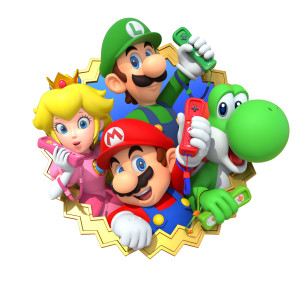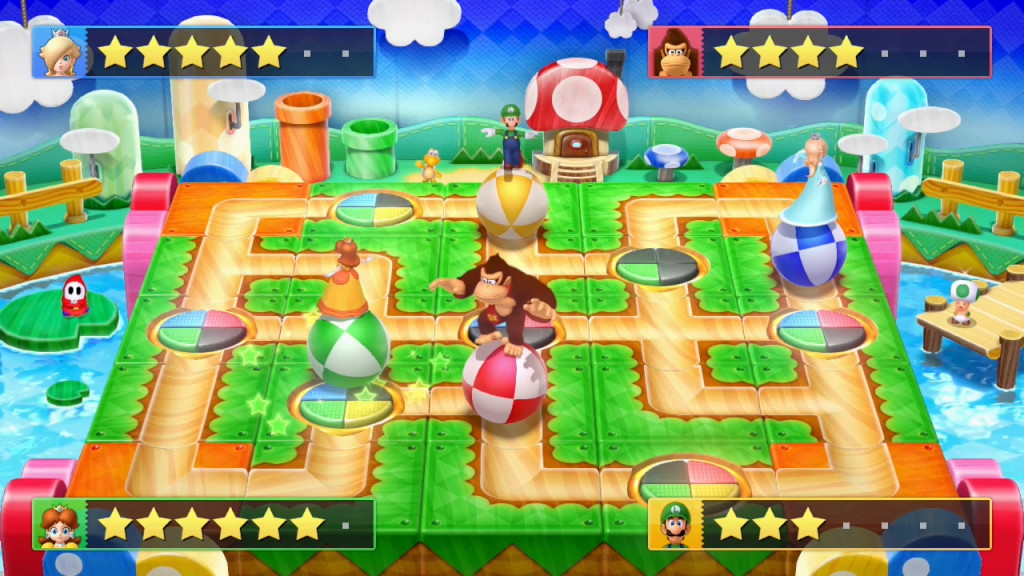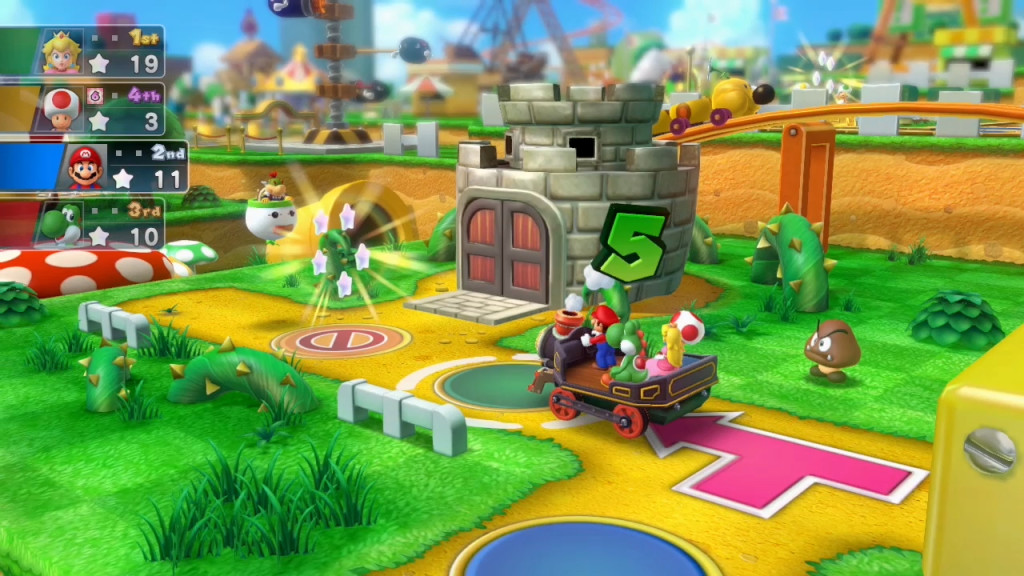Mario Party is one of those game series that, like Rock Band, is best played accompanied with several friends and several bottles of something cheeky. The clue is in the title: It’s a party. It isn’t a game you’re likely to play all alone, in your pants, at two in the afternoon. Not unless you’re reviewing it and aren’t wearing clothes because of..uh.. important critical analysis?
Mario Party 10, like the nine console games that came before it, will probably be used a handful of times a year. For those brief play-sessions of a couple of hours with a few friends after several bottles of the brown stuff, it will no doubt provide an enjoyable evening’s worth of entertainment.
However, taken as (what is technically) the thirteenth iteration in a long running game series, it could be used as the poster child for Nintendo’s relatively conservative approach to design. Take away the bells and whistles of Amiibo party (which is locked out unless you have specific characters anyway) and the few interesting new ideas presented in Bowser Party, and we’re left with a series that hasn’t changed much at all in the last 17 years.
 That being said, it’s a formula that works. Four friends battle it out across a game board, each vying to collect the most stars and get to the end first with the occasional mini game chucked in for good measure. It’s cheap (though not really), cheerful and Nintendo’s staple go-to when they need to plug a hole in the release window. Make some new boards, re-jigger the mini-games and chuck in some gimmick that makes use of Nintendo’s latest controller technology. Bish, bash, bosh. Done.
That being said, it’s a formula that works. Four friends battle it out across a game board, each vying to collect the most stars and get to the end first with the occasional mini game chucked in for good measure. It’s cheap (though not really), cheerful and Nintendo’s staple go-to when they need to plug a hole in the release window. Make some new boards, re-jigger the mini-games and chuck in some gimmick that makes use of Nintendo’s latest controller technology. Bish, bash, bosh. Done.
Mario Party 10 is no different, split into three vaguely-distinct modes: Mario Party, Amiibo Party and Bowser Party. Mario Party mode gives you pretty much the same experience of Mario Party 9, just prettied up in the Super Mario 3D World engine. Four players hop into a train, making their way around the board together in a bid to collect the most mini-stars. Coupling all the characters together was the best idea presented in Mario Party 9, so I’m happy that they’ve retained it in 10. It speeds up the flow of the game and removes the tedium of seeing each player move through the same obstacles over and again. It also adds an extra tactical element to proceedings, as rigged dice can be used to force other players onto harmful squares that steal their mini-stars or give you an advantage in events dotted around each board, such as trying to shoot down Bowser’s airship and picking the right treasure chest to receive a huge mini-star bonus from a friendly Dragoneel.
The gamepad is used in a rather neat way too, as Bowser’s prison. There’s six locks on it (one for each number on the dice), and with each dice roll players need to try and avoid unlocking it further. The person who finally frees the big angry bastard is ‘rewarded’ when he steals a bunch of their mini-stars and then adds some additional punishing squares to the board. He can even alter the rules in interesting ways, like making people win more stars by losing the mini games. This adds an extra element of tension to the game’s early stages, and it’s always fun to laugh at the poor unfortunate that inevitably unlocks Bowser’s cage. Once he’s released, the changes to gameplay help to shake things up just enough to keep the game interesting.
The mini games themselves, though, are pretty much just more of the same in this mode. They’re the usual mix of trying to grab the most fish you can, being the last one on a platform or hitting all the golf balls first. They all look lively enough, thanks to the rehashing of vast swathes of assets from Super Mario 3D World and are still as fun, but if you’ve played any other entry in the series you’ll know exactly what to expect, and there really is nothing new to excite.
 Amiibo party was easily my least favourite. It’s only playable if you have a compatible Mario-themed figure (all the usual faces plus Wario, Donkey Kong and Rosalina). I couldn’t help but find this fact utterly obnoxious, since it basically gates off a third of the game’s modes unless you spend an additional £10 (or £5 if you get the version bundled with a Mario Amiibo) on what is essentially a pretty plastic on-disc DLC key, and it’s not as though the game is exactly rammed with content to begin with. Very cheeky.
Amiibo party was easily my least favourite. It’s only playable if you have a compatible Mario-themed figure (all the usual faces plus Wario, Donkey Kong and Rosalina). I couldn’t help but find this fact utterly obnoxious, since it basically gates off a third of the game’s modes unless you spend an additional £10 (or £5 if you get the version bundled with a Mario Amiibo) on what is essentially a pretty plastic on-disc DLC key, and it’s not as though the game is exactly rammed with content to begin with. Very cheeky.
Once you’ve tapped your Amiibo on the gamepad, you’ll unlock new boards themed around the character you used. Mario gets you bog-standard mushroom kingdom fare, while Donkey Kong gives you a Jungle to play around in. You get the idea. Though each board is aesthetically different, they all basically play the same, just with a different skin, and once you’ve played through one, you’ve played them all. However, the gameplay in Amiibo Party hearkens back to the series’ annoying roots, ditching the train to let all members move round the board independently, returning to the original mechanic of trading coins for stars which throws all sense of skill out the window and returns to a game that is based almost entirely on luck and tedium.
It all feels so shoehorned in, like some order from on high came down telling Nd Cube to integrate Amiibos into it at the last minute. All in all, it feels like an afterthought. Put simply,you can unlock one board of classic mode for £10 extra, with the problem being that the original Mario Party was absolutely infuriating because it was woefully unbalanced, and so is Amiibo Party.
It’s a shame really, because the time they spent concocting this plastic-crap- DLC-driven-cash-grab could have been spent better refining the game’s best mode – Bowser Party.
 In Bowser Party, four players take on the roles of Mario and co. with Wiimotes, while a fifth uses the gamepad to control Bowser (this is also the only mode you can actually play if you don’t own any Wiimotes or Amiibos: Thanks, Nintendo). The premise is simple but very effective. The four players in the train have to try and get to the end of the board and collect the Super Star, while Bowser has to try and stop them by depleting all of their hearts before they get there, tearing up the game-board as he goes. Every time he catches up to the train, everyone plays a mini game in which he tortures the poor bastards in some sadistic way to try and wear down their reserves of hearts and hopefully knock them out of the game. As Bowser, you’ll be be blowing into the mic to attack the opposing team with fireballs, putting them on a giant roulette wheel and chucking bombs at anyone unfortunate enough to be on the wrong section when it stops spinning and just flat out jumping on the poor buggers.
In Bowser Party, four players take on the roles of Mario and co. with Wiimotes, while a fifth uses the gamepad to control Bowser (this is also the only mode you can actually play if you don’t own any Wiimotes or Amiibos: Thanks, Nintendo). The premise is simple but very effective. The four players in the train have to try and get to the end of the board and collect the Super Star, while Bowser has to try and stop them by depleting all of their hearts before they get there, tearing up the game-board as he goes. Every time he catches up to the train, everyone plays a mini game in which he tortures the poor bastards in some sadistic way to try and wear down their reserves of hearts and hopefully knock them out of the game. As Bowser, you’ll be be blowing into the mic to attack the opposing team with fireballs, putting them on a giant roulette wheel and chucking bombs at anyone unfortunate enough to be on the wrong section when it stops spinning and just flat out jumping on the poor buggers.
It may sound a little one-sided, but there’s plenty of opportunities for the team to escape from Bowser and the boards have liberal amounts of heart squares and other power-ups to increase the chances of the train getting to its final destination. Likewise, if Bowser is lagging behind too much, Bowser Junior will appear when the train makes it to the final stretch. He helps out his Pa by changing up the board, or sometimes just attacking the four guys in the train.
The problem here is that there simply isn’t enough of it. There aren’t that many mini games to mess about with, which is a shame because the asymmetric play is the easily the most interesting and fun aspect of the entire game, and it all feels very scant indeed.
It’s hard to recommend Mario Party 10, simply because how much enjoyment you can claw from the game is entirely dependent on whether you own a bunch of other stuff, with everything but Bowser Party being locked out if you don’t happen to own a bucket-full of additional Wiimotes and Amiibos. Even if you do already have all the necessary wagglesticks and figurines, though, how much fun you get out of Mario Party 10 will depend on whether you can corral enough people to play it, and how drunk they are when you do.

